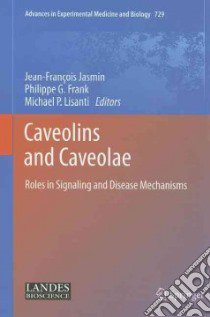Caveolins and Caveolae - 9781461412212
Un libro in lingua di Jasmin Jean-Francois Ph.D. (EDT) Frank Philippe G. Ph.D. (EDT) Lisanti Michael P. M.D. Ph.D. (EDT) edito da Landes Bioscience, 2012
- € 227.40
- Il prezzo è variabile in funzione del cambio della valuta d’origine
Caveolae are 50-100 nm flask-shaped invaginations of the plasma membrane that are primarily composed of cholesterol and sphingolipids. Using modern electron microscopy techniques, caveolae can be observed as omega-shaped invaginations of the plasma membrane, fully-invaginated caveolae, grape-like clusters of interconnected caveolae (caveosome), or as transcellular channels as a consequence of the fusion of individual caveolae. The caveolin gene family consists of three distinct members, namely Cav-1, Cav-2 and Cav-3. Cav-1 and Cav-2 proteins are usually co-expressed and particularly abundant in epithelial, endothelial, and smooth muscle cells as well as adipocytes and fibroblasts. On the other hand, the Cav-3 protein appears to be muscle-specific and is therefore only expressed in smooth, skeletal and cardiac muscles. Caveolin proteins form high molecular weight homo- and/or hetero-oligomers and assume an unusual topology with both their N- and C-terminal domains facing the cytoplasm.
Informazioni bibliografiche
- Titolo del Libro in lingua: Caveolins and Caveolae
- Sottotitolo: Roles in Signaling and Disease Mechanisms
- Lingua: English
- Autori : Jasmin Jean-Francois Ph.D. (EDT) Frank Philippe G. Ph.D. (EDT) Lisanti Michael P. M.D. Ph.D. (EDT)
- Editore: Landes Bioscience
- Collana: Landes Bioscience (Hardcover)
- Data di Pubblicazione: 30 Gennaio '12
- Genere: MEDICAL
- Argomenti : Caveolins physiology Caveolae pathology Caveolae physiology
- Pagine: 184
- ISBN-10: 1461412218
- EAN-13: 9781461412212


